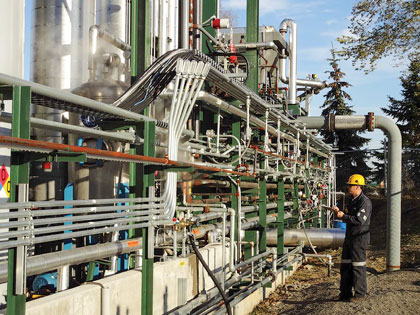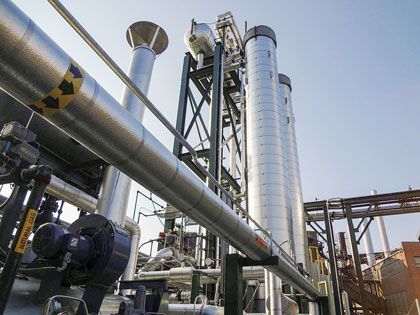Executive Q&A viewpoint-Schuetzle
Robert Schuetzle, President and CEO, Greyrock Energy, Sacramento, California
All fuels are not created equal, claims Greyrock Energy. Fuels produced via the company’s award-winning, proprietary GTL process are said to be superior to oil-derived fuels for a variety of reasons, including performance and environmental friendliness. The process also solves challenges for upstream operators working in remote areas, in regions lacking infrastructure, or in shale plays that are rich in natural gas.
In 2014, Greyrock was recognized by the World Bank’s Global Gas Flare Reduction Partnership as the most advanced new technology provider of mini-GTL systems in a report evaluating associated gas monetization solutions.
Also in 2014, Greyrock formed a partnership with Expander Energy to build GTL facilities in Alberta, British Columbia and elsewhere in Canada. In 2015, Greyrock formed a partnership with Nerd Gas to build GTL facilities in the US, in addition to forming relationships with Sterling Private Capital and Eagle Oil for future projects.
What makes Greyrock’s GTL process so promising? Gas Processing talked with Greyrock President and CEO Robert Schuetzle to find out.
GP. What drivers led you to form Greyrock?
Schuetzle. We formed Greyrock as a privately held company in 2006 in response to the premise that there is a large market for what we call distributed gas to liquids (dGTL), as opposed to the massive scales of GTL facilities that are in operation.
Shell and Sasol are really the only two practitioners in the world that do GTL, and those are multibillion-dollar, refinery-scale assets in South Africa, Qatar and a few other locations. For companies that are deploying at that kind of scale, their model and the technology they use works, and some argue that those are some of the most profitable energy assets in the world.
However, when you look at shrinking the scale of GTL, converting natural gas or NGL into fuels on a small scale, and doing that in a distributed manner as opposed to a centralized manner, the technology and business model that have been typically used really don’t work.
This company was founded on the premise that there is a better way to do small-scale GTL, and we have been a leader in this space ever since. We have core technology that allows us to do small-scale GTL economically, in much smaller scale than the majors, and it allows us to place these facilities in shale gas regions where feedstock is abundant, so that feedstock costs for our plants can be dramatically reduced.
GP. You specialize in modular deployment of these plants. What does the footprint of these small-scale plants look like?
Schuetzle. The use of modular construction has allowed us to build at our partner fabrication facilities. We have a number of fabrication partners. Many of them are on the US Gulf Coast, and that allows us to control capital costs and quality in a manufacturing environment, instead of doing a lot of work in the field, as is traditional in larger-scale applications. So, there is some benefit there.
Depending on the size of the plant that the customer chooses, the footprint can vary, and the number of skids can vary. At minimum, we are probably talking about 15 or so skids that go into one of these units. They are shipped to the site and are plumbed up together, and then they are ready for operation.
For the footprint that these plants sit on, we usually encourage the customer to reserve 10 acres for the whole facility. The hardware itself sits on about two acres, so they have fairly small footprints compared to a large-scale GTL facility, which can take hundreds to thousands of acres. These smaller GTL facilities are a good fit for deployment in a number of locations, especially in the shale geographies where our customers deploy.
GP. In what kind of lead time can your customers expect to have one of these plants built onsite?
Schuetzle. It depends on the geography, but the lead times for the plants that we are delivering now are about 12 months. So, about one year from start to finish.
Greyrock is working with suppliers to try to shrink that lead time, because getting these plants in the field in the quickest time possible, to take advantage of flare gas opportunities or disadvantaged gas pricing, is advantageous.
GP. In addition to size and flexibility, how does your GTL technology differ from the norm?
Schuetzle. We have two major processes in the Greyrock solution. The first is syngas generation, which allows us to convert natural gas (methane) or NGL (such as ethane or propane) into synthesis gas, or syngas, which contains hydrogen and carbon monoxide. As a precursor to the syngas step, we remove the sulfur from the feedstock.
The next stage is where we run the syngas over our catalyst to produce diesel fuel. This step is unique because it allows us to go directly from syngas to diesel fuel without having to refine that product. Traditional Fischer-Tropsch methods turn syngas into wax (paraffin), and then the wax has to be refined and processed back into fuel.
Since our catalyst allows us to eliminate that major refining step, we can reduce costs and simplify the plant. The formula of our catalyst is only known to a few people at Greyrock. Our chief technology officer worked on a number of catalyst projects at Ford Motor Co., and many of our founding managers are from major catalyst companies that have done a lot of work on commercial catalysts.
We’ve focused on making sure that this catalyst is composed of widely available materials that are not subject to wild fluctuations in commodity pricing. That was job No. 1 when we started this in 2006. The catalyst is manufactured in the US, and the materials are sourced from within the US.
GP. How does this diesel fuel differ from oil-sourced diesel fuel?
Schuetzle. The quality of the fuel is much higher than that of traditional diesel fuel. Similar to other GTL fuels, Greyrock diesel fuel not only meets road specifications, but it also goes above and beyond those specifications to deliver a higher-quality performance.
For example, the cetane rating in Greyrock GTL diesel fuel is above 70. The higher the cetane number, the more easily the fuel will combust in a compression-ignition (diesel) engine. Petroleum-derived diesel fuel has a cetane rating of approximately 45. GTL is a premium-cetane fuel, which allows for better combustion qualities.
This fuel also contains zero sulfur, and, depending on the type of engine in which it is being used, it can offer dramatic reductions in particulate matter and NOx. Greyrock’s fuel also has superior lubricity, which is different from traditional GTL fuels. Zero sulfur content, high cetane number, and superior lubricity also make the fuel a great blendstock with petroleum fuels.
Also, this process is feedstock-flexible. The customer can use natural gas, and we’ve had a lot of interest in using ethane (and other NGL) in these GTL facilities. A lot of these liquids-rich shale basins are finding that the liquids are becoming a problem, so they have excess NGL.
GP. How long did it take to scale up to commercial quantities?
Schuetzle. The catalyst took several years to develop, including a couple of years of research and development, followed by a pilot-scale unit for two years. After that, we moved to a commercial demonstration unit in Toledo, Ohio (Fig. 1).
 |
|
Fig. 1. Greyrock Energy’s 30-bpd commercial demonstration plant in Toledo, Ohio |
It took three scale-ups and six to seven years to make sure that the catalyst worked in a commercial environment. Today, the Toledo facility is the largest commercial demonstration GTL asset in North America (Fig. 2).
 |
|
Fig. 2. Greyrock’s Toledo, Ohio facility is the largest commercial demonstration |
GP. What type of equity-partner arrangements do you offer?
Schuetzle. Greyrock Equity Partners (a subsidiary of Greyrock Energy) was set up to partner with our customers to provide more than just technology. We provide experience in project development and also, in some cases, capital to help our customers solve a problem and bring one of our dGTL projects to the region. Greyrock Equity Partners holds equity in some of our customers’ GTL projects.
GP. If needed by your customers, what services can Greyrock offer?
Schuetzle. Greyrock Services (another subsidiary of Greyrock Energy) delivers the dGTL solutions to customers, so that, when we get a plant order, Greyrock Services is responsible for overseeing the fabrication, delivering the skids to the site and, in some cases, taking on construction for the customer. This system allows our customers to avoid hiring an engineering and construction firm and to manage their learning curve on our technology.
We are a one-stop GTL shop for our partners and customers. We’re excited about this technology and looking forward to deploying these facilities throughout North America for our customers. GP
 |
Robert Schuetzle is the president and CEO of Greyrock Energy, as well as a board member, with nearly 20 years of experience in the energy industry. He is a serial entrepreneur, having founded several companies. At Greyrock, Mr. Schuetzle leads the development of a unique GTL platform for the direct production of hydrocarbon fuels and chemicals, using distributed plants. He previously founded and sold a high-technology company, managed and sold complex land development projects, and was a principal consultant for Global 2000 clients in the Americas, Europe and Asia-Pacific. Mr. Schuetzle obtained his BS degree in mechanical engineering from the University of Michigan and the University of New South Wales in Australia. He has served as an advisor to federal, state and local agencies on energy programs; is a frequent industry speaker; has published technical papers on energy and fuels; and holds seven patents.




Comments